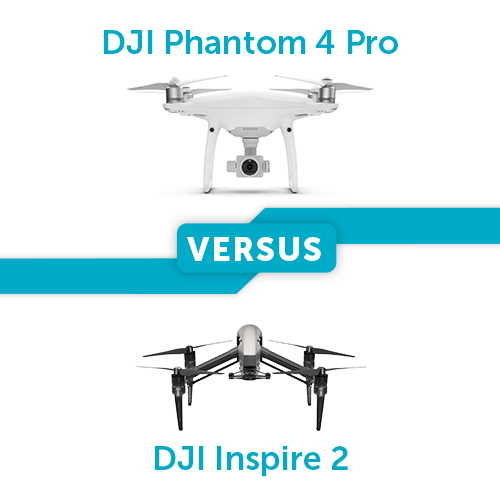
Products
DJI Phantom 4 Pro Versus DJI Inspire 2
Heliguy Insider compares the DJI Phantom 4 Pro and Inspire 2 in the latest versus post looking appearance, performance and the cameras. ... Read More
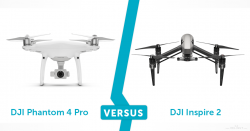
Specifications
Take a look at the below specifications for each drone.
1479384586Phantom_4_Pro-small.png DJI Phantom 4 Pro | 1501566605Inspire_2_no_camera-small.png DJI Inspire 2 |
Aircraft
#### Weight | 1388 g (Battery & Propellers Included) | 3440 g (including propellers and two batteries, without gimbal and camera) |
#### Max Takeoff Weight | N/A | 4000 g |
#### Diagonal Size | 350 mm (Propellers Excluded) | 605 mm (Propeller excluded, Landing Mode) |
#### Max Ascent Speed | P-mode: 5 m/s; S-mode: 6 m/s | P-mode/A-mode: 5 m/s; S-mode: 6 m/s |
#### Max Descent Speed | P-mode: 3 m/s; S-mode: 4 m/s | Vertical: 4 m/s; Tilt: 4-9 m/s |
#### Max Speed | S-mode: 45 mph (72 kph); A-mode: 36 mph (58 kph); P-mode: 31 mph (50 kph) | Sport mode: 58 mph (94 kph) |
#### Max Tilt Angle | S-mode: 42°; A-mode: 35°; P-mode: 25° | S-mode: 40°; A-mode: 35°; P-mode: 35° (Forward Vision System enabled: 25°) |
#### Max Angular Speed | S-mode: 250°/s; A-mode: 150°/s | Pitch: 300°/s; Yaw: 150°/s |
#### Max Service Ceiling Above Sea Level | 6000 m | 2500 m; 5000 m with specially-designed propeller |
#### Max Wind Speed Resistance | 10 m/s | 10 m/s |
#### Max Flight Time | Approx. 30 minutes | Approx. 27 min (with Zenmuse X4S) |
#### Operating Temperature Range | 0° to 40°C | -20° to 40°C |
#### Hover Accuracy Range | Vertical: ±0.1 m (with Vision Positioning); ±0.5 m (with GPS Positioning) Horizontal: ±0.3 m (with Vision Positioning); ±1.5 m (with GPS Positioning) | Vertical: ±0.5 m or ±0.1 m (Downward Vision System enabled) Horizontal: ±1.5 m or ±0.3 m (Downward Vision System enabled) |
Gimbal
#### Model | N/A | ZENMUSE X4S (optional), ZENMUSE X5S (optional), ZENMUSE X7 (optional) |
#### Stabilization | 3-axis (pitch, roll, yaw) | N/A |
#### Controllable Range | Pitch: -90° to +30° | Pitch: -130° to +40°; Roll: ±20°; Pan: ±320° |
#### Max Controllable Angular Speed | Pitch: 90°/s | Pitch: 180°/s; Roll: 180°/s; Pan: 270°/s |
#### Angular Control Accuracy | ±0.02° | ±0.01° |
#### Interface Type | N/A | Detachable |
#### Mechanical Range | N/A | Pitch: -140° to +50°; Roll: -50° to +90°; Pan: ±330° |
Camera
#### Sensor | 1" CMOS; Effective pixels: 20M | Zenmuse X4S 1" CMOS; Effective Pixels: 20 MP Zenmuse X5S 4/3" CMOS; Effective Pixels: 20.8MP Zenmuse X7 Sensor Size (Still): 23.5 x 15.7 mm; Sensor Size (Max video recording area): 23.5 x 12.5 mm; Effective Pixels: 24 MP |
#### Lens | FOV 84° 8.8 mm/24 mm (35 mm format equivalent) f/2.8 - f/11 auto focus at 1 m - ∞ | Zenmuse X4S F/2.8-11, 8.8 mm (35 mm Equivalent: 24 mm) Zenmuse X5S DJI MFT 15 mm / 1.7 ASPH (With Balancing Ring and Lens Hood); Panasonic Lumix 15 mm / 1.7 (With Balancing Ring and Lens Hood); Panasonic Lumix 14-42 mm / 3.5 - 5.6 HD; Olympus M.Zuiko 12 mm / 2.0 (With Balancing Ring); Olympus M.Zuiko 17 mm / 1.8 (With Balancing Ring); Olympus M.Zuiko 25 mm / 1.8; Olympus M.Zuiko 45 mm / 1.8; Olympus M.Zuiko 9-18 mm / 4.0-5.6 Zenmuse X7 DJI DL-S 16 mm F2.8 ND ASPH (with lens hood and balancing ring/filter); DJI DL 24 mm F2.8 LS ASPH (with lens hood and balancing ring/filter); DJI DL 35 mm F2.8 LS ASPH (with lens hood and balancing ring/filter); DJI DL 50 mm F2.8 LS ASPH (with lens hood and balancing ring/filter |
#### ISO Range | Video: 100 - 3200 (Auto); 100 - 6400 (Manual) Photo: 100 - 3200 (Auto); 100- 12800 (Manual) | Zenmuse X4S Video: 100 - 6400 Stills: 100 - 12800 Zenmuse X5S Video: 100 - 6400 Still: 100 - 25600 Zenmuse X7 Photo: 100 - 25600 Video: 100 - 1600 (EI mode on); 100 - 6400 (EI mode off) |
#### Shutter Speed | Mechanical Shutter: 8 - 1/2000 s; Electronic Shutter: 8 - 1/8000 s | Zenmuse X4S Mechanical Shutter: 8 – 1/2000s; Electronic Shutter: 1/2000 – 1/8000s Zenmuse X5S Electronic Shutter: 8-1/8000s Zenmuse X7 Electronic Shutter Speed: 1/8000 - 8s; Mechanical Shutter Speed: 1/1000 - 8s (DJI DL-S 16mm F2.8 ND ASPH not supported) |
#### Image Size | 3:2 Aspect Ratio: 5472 x 3648; 4:3 Aspect Ratio: 4864 x 3648; 16:9 Aspect Ratio: 5472 x 3078 | Zenmuse X4S 3:2, 5472 x 3648; 4:3, 4864 x 3648; 16:9, 5472 x 3078 Zenmuse X5S 4:3, 5280 x 3956; 16:9, 5280 x 2970 Zenmuse X7 3:2, 4:3, 16:9 |
#### PIV Image Size | 4096 x 2160 (4096 x 2160 24 / 25 / 30 / 48 / 50p); 3840 x 2160 (3840 x 2160 24 / 25 / 30 / 48 / 50 / 60p); 2720 x 1530 (2720 x 1530 24 / 25 / 30 / 48 / 50 / 60p); 1920 x 1080 (1920 x 1080 24 / 25 / 30 / 48 / 50 / 60 / 120p); 1280 x 720 (1280 x 720 24 / 25 / 30 / 48 / 50 / 60 / 120p) | N/A |
#### Still Photography Modes | Single Shot; Burst Shooting: 3 / 5 / 7 / 10 / 14 frames; Auto Exposure Bracketing (AEB): 3/5 bracketed frames at 0.7 EV Bias; Interval: 2 / 3 / 5 / 7 / 10 / 15 / 20 / 30 / 60 s | Zenmuse X4S Single shot; Burst shooting: 3 / 5 / 7 / 10 / 14 frames; Auto Exposure Bracketing; 3/5 bracketed frames at 0.7EV bias; Interval Zenmuse X5S Micro SD: Single shot, Burst Shooting: 3 / 5 / 7 / 10 / 14 frames, Auto Exposure Bracketing, 3 / 5 bracketed frames at 0.7EV bias, Timelapse SSD: RAW Burst Shooting: 3 / 5 / 7 / 10 / 14 / 20 / ∞ frames Zenmuse X7 Micro SD: Single Shot, Burst Shooting (3 / 5 / 7 / 10 shots), Auto Exposure Bracketing (3 / 5 bracketed shots at 0.7 EV bias), Interval SSD: RAW Burst (3 / 5 / 7 / 10 / 14 / ∞ frames), up to 20 fps when using RAW Burst (exact quantity is determined by storage card capacity and battery power level) |
#### Video Recording Modes | H.265 C4K: 4096 x 2160 24 / 25 / 30p @100Mbps 4K: 3840 x 2160 24 / 25 / 30p @100Mbps 2.7K: 2720 x 1530 24 / 25 / 30p @65Mbps 2.7K: 2720 x 1530 48 / 50 / 60p @80Mbps FHD: 1920 x 1080 24 / 25 / 30p @50Mbps FHD: 1920 x 1080 48 / 50 / 60p @65Mbps FHD: 1920 x 1080 120p @100Mbps HD: 1280 x 720 24 / 25 / 30p @25Mbps HD: 1280 x 720 48 / 50 / 60p @35Mbps HD: 1280 x 720 120p @60Mbps H.264 C4K: 4096 x 2160 24 / 25 / 30 / 48 / 50 / 60p @100Mbps 4K: 3840 x 2160 24 / 25 / 30 / 48 / 50 / 60p @100Mbps 2.7K: 2720 x 1530 24 / 25 / 30p @80Mbps 2.7K: 2720 x 1530 48 / 50 / 60p @100Mbps FHD: 1920 x 1080 24 / 25 / 30p @60Mbps FHD: 1920 x 1080 48 / 50 / 60 @80Mbps FHD: 1920 x 1080 120p @100Mbps HD: 1280 x 720 24 / 25 / 30p @30Mbps HD: 1280 x 720 48 / 50 / 60p @45Mbps HD: 1280 x 720 120p @80Mbps | Zenmuse X4S H.264 C4K: 4096 x 2160 23.976 / 24 / 25 / 29.97 / 47.95 / 50 / 59.94p @100Mbps 4K: 3840 x 2160 23.976 / 24 / 25 / 29.97 / 47.95 / 50 / 59.94p @100Mbps 2.7K: 2720 x 1530 23.976 / 24 / 25 / 29.97p @80Mbps 47.95 / 50 / 59.94p @100Mbps FHD: 1920 x 1080 23.976 / 24 / 25 / 29.97p @60Mbps 47.95 / 50 / 59.94p @80Mbps 119.88p @100Mbps H.265 C4K: 4096 x 2160 23.976 / 24 / 25 / 29.97p @100Mbps 4K: 3840 x 2160 23.976 / 24 / 25 / 29.97p @100Mbps 2.7K: 2720 x 1530 23.976 / 24 / 25 / 29.97p @65Mbps 47.95 / 50 / 59.94p @80Mbps FHD: 1920 x 1080 23.976 / 24 / 25 / 29.97p @50Mbps 47.95 / 50 / 59.94p @65Mbps 119.88p @100Mbps Zenmuse X5S Aspect Ratio 17:9 CinemaDNG 4K DCI: 4096 x 2160 23.976 / 24 / 25 / 29.97p, up to 2.4Gbps; 50 / 59.94p, up to 4.0Gbps H.264 4K DCI: 4096 x 2160 23.976 / 24 / 25 / 29.97 / 47.95 / 50 / 59.94p @100Mbps H.265 4K DCI: 4096 x 2160 23.976 / 24 / 25 / 29.97p @100Mbps Aspect Ratio 16:9 CinemaDNG 4K Ultra HD: 3840 x 2160 23.976 / 24 / 25 / 29.97p, up to 2.4Gbps; 50 / 59.94p, up to 4.0Gbps ProRes 4K Ultra HD: 3840 x 2160 23.976 / 24 / 25 / 29.97p, 422 HQ @900Mbps; 23.976 / 24 / 25 / 29.97p, 4444 XQ @2.0Gbps H.264 4K Ultra HD: 3840 x 2160 23.976 / 24 / 25 / 29.97 / 47.95 / 50 / 59.94p @100Mbps 2.7K: 2720 x 1530 23.976 / 24 / 25 / 29.97p @80Mbps; 47.95 / 50 / 59.94p @100Mbps FHD: 1920 x 1080 23.976 / 24 / 25 / 29.97p @60Mbps; 47.95 / 50 / 59.94p @80Mbps; 119.88p @100Mbps H.265 4K Ultra HD: 3840 x 2160 23.976 / 24 / 25 / 29.97p @100Mbps 2.7K: 2720 x 1530 23.976 / 24 / 25 / 29.97p @65Mbps; 47.95 / 50 / 59.94p @80Mbps FHD: 1920 x 1080 23.976 / 24 / 25 / 29.97p @50Mbps; 47.95 / 50 / 59.94p @65Mbps; 119.88p @100Mbps Aspect Ratio 2.44:1 CinemaDNG 5.2K: 5280 x 2972 23.976 / 24 / 25 / 29.97p, up to 4.2Gbps ProRes 5.2K: 5280 x 2160 23.976 / 24 / 25 / 29.97p, 422 HQ @1.3Gbps H.264 / H.265 4K Ultra HD: 3840 x 1572 23.976 / 24 / 25 / 29.97p @100Mbps Zenmuse X7 Aspect Ratio 17:9 CinemaDNG 6K: 6016 x 3200, 23.976 / 24 / 25 / 29.97 / 30p, 12-bit, full FOV 4K DCI: 4096 x 2160, 23.976 / 24 / 25 / 29.97 / 30p, 12-bit, full FOV 3.9K: 3944 x 2088, 47.95 / 50 / 59.94, 12-bit, narrow FOV ProRes 4K DCI: 4096 x 2160, 23.976 / 24 / 25 / 29.97 / 30p, 10-bit, HQ, full FOV 2K: 2048 x 1080, 47.95 / 50 / 59.94p, 10-bit, HQ / XQ, narrow FOV H.264 4K DCI: 4096 x 2160, 24 / 25 / 30 / 48 / 50 / 59.94p H.265 4K DCI: 4096 x 2160, 24 / 25 / 30p Aspect Ratio 16:9 CinemaDNG 6K: 5760 x 3240, 23.976 / 24 / 25 / 29.97 / 30p, 12-bit, full FOV 4K Ultra HD: 3840 x 2160, 23.976 / 24 / 25 / 29.97 / 30p, 12-bit, full FOV 3.7K: 3712 x 2088, 47.95 / 50 / 59.94, 12-bit, narrow FOV ProRes 4K Ultra HD: 3840 x 2160, 23.976 / 24 / 25 / 29.97p, 10-bit, HQ / XQ, full FOV 2.7K: 2704 x 1520, 47.95 / 50 / 59.94p, 10-bit, HQ, narrow FOV FHD:1920 x 1080, 47.95 / 50 / 59.94p, 10-bit, HQ / XQ, narrow FOV H.264 4K Ultra HD: 3840 x 2160, 24 / 25 / 30 / 48 / 50 / 59.94p 2.7K: 2720 x 1530, 24 / 25 / 30 / 48 / 50 / 59.94p FHD: 1920 x 1080, 24 / 25 / 30 / 48 / 50 / 59.94p HD: 1280 x 720, 24 / 25 / 30 / 48 / 50 / 59.94p H.265 4K Ultra HD: 3840 x 2160, 24 / 25 / 30p 2.7K: 2720 x 1530, 24 / 25 / 30 / 48 / 50 / 59.94p FHD: 1920 x 1080, 24 / 25 / 30 / 48 / 50 / 59.94p HD: 1280 x 720, 24 / 25 / 30 / 48 / 50 / 59.94p Aspect Ratio 2.44:1 ProRes 5.2K: 5280 x 2160, 23.976 / 24 / 25 / 29.97 / 30p, 10-bit, HQ, full FOV H.264 / H.265 4K Ultra HD: 3840 x 1572, 30p, full FOV Refer to the User Manual for more information. |
#### Photo Formats | JPEG, DNG (RAW), JPEG + DNG | DNG, JPEG, DNG + JPEG |
#### Video Formats | MP4/MOV (AVC/H.264; HEVC/H.265) | Zenmuse X4S MOV, MP4 Zenmuse X5S RAW, ProRes, MOV, MP4 Zenmuse X7 CINESSD: CinemaDNG, ProRes; Micro SD: MOV, MP4 |
#### Operating Temperature Range | 0° to 40°C | Zenmuse X4S and Zenmuse X5S -10° to 40°C Zenmuse X7 -20° to 40°C |
Vision System
#### Vision System | Forward Vision System, Backward Vision System, Downward Vision System | Forward Vision System, Downward Vision System |
#### Velocity Range | ≤31 mph (50 kph) at 2 m above ground | <32.8 ft/s (10 m/s) at height of 2 m |
#### Altitude Range | 0 - 10 m | < 10 m |
#### Operating Range | 0 - 10 m | < 10 m |
#### Obstacle Sensory Range | 0.7 - 30 m | 0.7 - 30 m (Forward Vision System) |
#### FOV | Forward: 60°(Horizontal), ±27°(Vertical); Backward: 60°(Horizontal), ±27°(Vertical); Downward: 70°(Front and Rear), 50°(Left and Right) | Forward: 60° (Horizontal); 54° (Vertical) |
#### Measuring Frequency | Forward: 10 Hz; Backward: 10 Hz; Downward: 20 Hz | N/A |
#### Operating Environment | Surface with clear pattern and adequate lighting (lux>15) | Surfaces with clear patterns and adequate lighting (> 15 lux) |
#### Ultrasonic Sensor Operating Range | N/A | 10-500 cm (Downward) |
#### Ultrasonic Sensor Operating Environment | N/A | Non-absorbing material, rigid surface (thick indoor carpeting will reduce performance) (Downward) |
Infrared Sensing System
#### Obstacle Sensory Range | 0.2 - 7 m | 0 - 5 m (Upward Infrared Sensor) |
#### FOV | 70° (Horizontal), ±10° (Vertical) | ±5° (Upward Infrared Sensor) |
#### Measuring Frequency | 10 Hz | N/A |
#### Operating Environment | Surface with diffuse reflection material, and reflectivity > 8% (such as wall, trees, humans, etc.) | Large-size non-reflective obstacles |
Charger
#### Voltage | 17.4 V | 26.1 V |
#### Rated Power | 100 W | 180 W |
Remote Controller
#### Operating Frequency | 2.400 - 2.483 GHz and 5.725 - 5.825 GHz | 2.400 - 2.483 GHz and 5.725 - 5.850 GHz |
#### Max Transmission Distance (Unobstructed, free of interference) | 2.400 - 2.483 GHz FCC: 7 km; CE: 3.5 km; SRRC: 4 km 5.725 - 5.825 GHz FCC: 7 km; CE: 2 km; SRRC: 5 km | 2.4 GHz FCC: 4.3 miles (7 km); CE: 2.2 miles (3.5 km); SRRC: 2.5 miles (4 km); MIC: 2.5 miles (4 km); 5.8 GHz FCC: 4.3 miles (7 km); CE: 1.2 miles (2 km); SRRC: 3.1 miles (5 km); MIC: - |
#### Operating Temperature Range | 0° to 40°C | -20° to 40° C |
#### Battery | 6000 mAh LiPo 2S | 6000 mAh LiPo 2S |
#### Transmitter Power (EIRP) | 2.400 - 2.483 GHz FCC: 26 dBm; CE: 17 dBm; SRRC: 20 dBm; MIC: 17 dBm 5.725 - 5.825 GHz FCC: 28 dBm; CE: 14 dBm; SRRC: 20 dBm; MIC: - | 2.4 GHz FCC: 26 dBm; CE: 17 dBm; SRRC: 20 dBm; MIC: 17dBm; 5.8 GHz FCC: 28 dBm; CE:14 dBm; SRRC: 20 dBm; MIC: - |
#### Operating Current / Voltage | 1.2 A @ 7.4 V | USB Supply Power iOS: 1 A @ 5.2 V (Max); Android: 1.5 A @ 5.2 V (Max) |
#### Video Output Port | GL300E: HDMI; GL300F: USB | USB, HDMI |
#### Mobile Device Holder | GL300E: Built-in display device (5.5 inch screen, 1920x1080, 1000 cd/m2, Android system, 4 GB RAM+16 GB ROM) GL300F: Tablets and smart phones | Tablet or Smart Phone; Max Mobile Device Width: 170 mm |
Intelligent Flight Battery
#### Capacity | 5870 mAh | 4280 mAh (Standard TB50) |
#### Voltage | 15.2 V | 22.8 V (Standard TB50) |
#### Battery Type | LiPo 4S | LiPo 6S (Standard TB50) |
#### Energy | 89.2 Wh | 97.58 Wh (Standard TB50) |
#### Net Weight | 468 g | 515 g (Standard TB50) |
#### Charging Temperature Range | 5° to 40°C | 5° to 40°C (Standard TB50) |
#### Max Charging Power | 100 W | 180 W (Standard TB50) |
What’s Included?
Now you know the specifications, take a look at what's included with each aircraft.
What's Included?
1479384586Phantom_4_Pro-small.png DJI Phantom 4 Pro | * Aircraft Body * Remote Controller * Propellers * Intelligent Flight Battery * Battery Charger * Power Cable * Gimbal Clamp * USB OTG Cable * Micro USB Cable * Micro SD Card (16 GB) * Carrying Case |
* Aircraft Body * Remote Controller * Propellers (Pair) * Intelligent Flight Battery (TB50) * Battery Charger * Charging Hub * Power Cable * USB Cable (with Double-A Ports) * Micro SD Card (16 GB) * Vision System Calibration Plate * Gimbal Damper * Propeller Mounting Plates * Carrying Case * Battery Insulation Sticker | 1501566605Inspire_2_no_camera-small.png DJI Inspire 2 |
As you can see, there’s very little difference between the standard versions of the aircraft. Each aircraft comes with a carry case which gives you storage and transport options. It’s worth noting, the Phantom 4 Pro is also available in the Phantom 4 Pro+ which comes with a built-in 1,000nit display on the remote controller.
Appearance
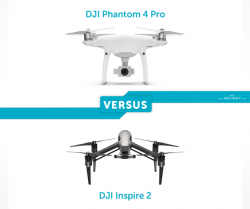
Performance
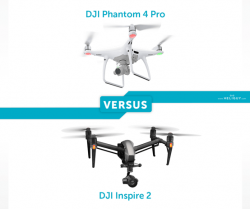
Camera
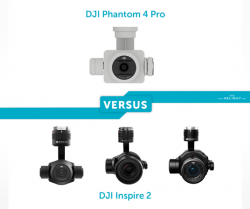
Battery Life
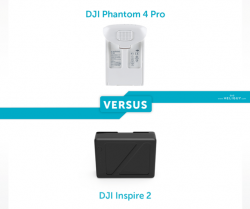
Summary
It's clear to see reasons why the Phantom 4 Pro and the Inspire 2 are at the top of the consumer and professional drone markets. They are both exceptional aircraft capable of producing extremely high-quality images and video. However, there are aspects that do set the aircraft apart. The Inspire 2 offers more flexibility over the cameras, lenses and the CinemaDNG and Apple ProRes licence capabilities. These features do come at an increased price, especially when buying the cameras, separate lenses and licences, which can be expensive than the Phantom 4 Pro. If you're wanting an aircraft for high-end, cinema-level video and image production, the Inspire 2 is likely to be the best aircraft for your line of work. If you're a photographer or videographer who doesn't need the capabilities of the Inspire 2, the Phantom 4 Pro is an ideal aircraft for you. It is also better suited to individuals so if you're working by yourself, controlling the Phantom 4 Pro may be easier. Whichever aircraft you choose, you're not going to be unhappy as they're some of the best drones from DJI to date.
For any questions about any of the above information or DJI or Freefly products, please contact a member of the Heliguy Team on 0191 249 4695 or email us at info@heliguy.com.
Keep checking back to Heliguy’s Insider Blog for more announcements, insights into drones and, of course, the latest news from the drone industry.
